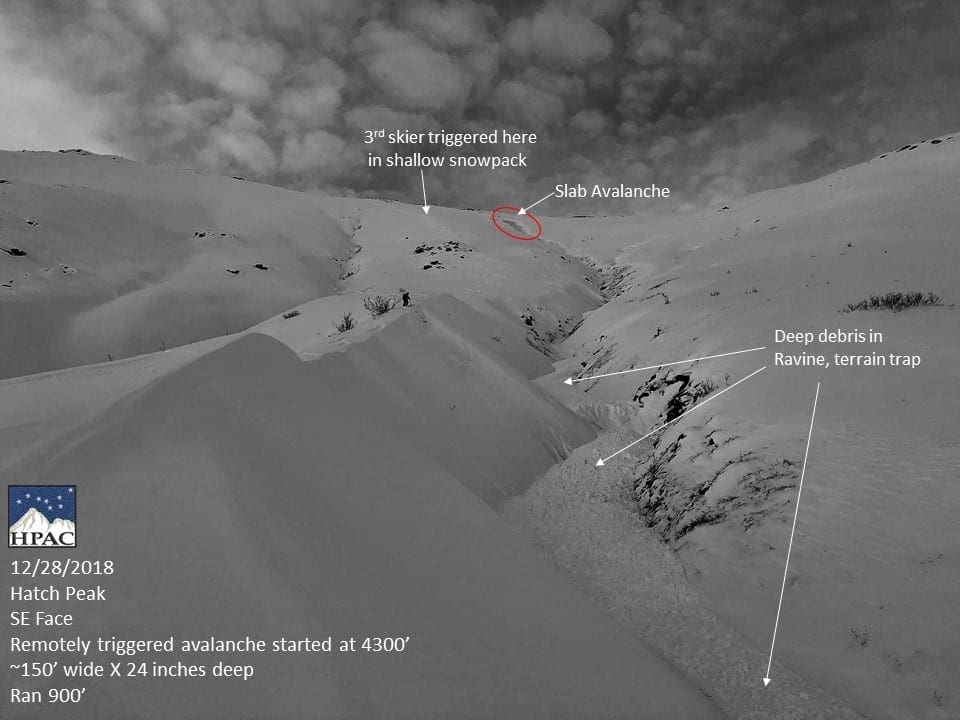

Hatcher Pass
|
|
The avalanche hazard is MODERATE this morning and may rise to CONSIDERABLE this afternoon, depending on the amount of accumulated new snow and strength of the wind today.
A moderate hazard for human triggered avalanches 1-4 feet deep at mid to upper elevations exists. Avalanches will be possible to trigger this weekend and tricky to predict. REMOTELY triggered avalanches will be possible in some locations. Warning signs, such as whumphing and shooting cracks, may NOT be present.
AVOID STEEP SLOPES WITH TERRAIN TRAPS, and choose slopes with gentle, fanning runouts.
Moderate avalanche hazard does NOT equal safe conditions everywhere. Deciphering the avalanche puzzle will be challenging, with large (D2), human triggered avalanches possible on a multitude of weak layers in the snowpack for an avalanche to choose to fail on.
Mark your calendars for the annual Hatcher Pass Avalanche Workshop coming up on Saturday January 19th.

| |
|
|
|
|
|
| Travel Advice | Generally safe avalanche conditions. Watch for unstable snow on isolated terrain features. | Heightened avalanche conditions on specific terrain features. Evaluate snow and terrain carefully; identify features of concern. | Dangerous avalanche conditions. Careful snowpack evaluation, cautious route-finding, and conservative decision-making essential. | Very dangerous avalanche conditions. Travel in avalanche terrain not recommended. | Extraordinarily dangerous avalanche conditions. Avoid all avalanche terrain. |
| Likelihood of Avalanches | Natural and human-triggered avalanches unlikely. | Natural avalanches unlikely; human-triggered avalanches possible. | Natural avalanches possible; human-triggered avalanches likely. | Natural avalanches likely; human-triggered avalanches very likely. | Natural and human-triggered avalanches certain. |
| Avalanche Size and Distribution | Small avalanches in isolated areas or extreme terrain. | Small avalanches in specific areas; or large avalanches in isolated areas. | Small avalanches in many areas; or large avalanches in specific areas; or very large avalanches in isolated areas. | Large avalanches in many areas; or very large avalanches in specific areas. | Very large avalanches in many areas. |
Stability has increased very slowly over the last two weeks, but significant flaws in the architecture of the snowpack remain. While the probability of triggering an avalanche has decreased, the consequences have not. Avalanches will be possible, large enough to bury, injure to kill a person, and difficult to predict. Remotely triggered avalanches will be possible in some locations. Avoid terrain traps.
A MODERATE avalanche hazard at mid to upper elevations for persistent slabs, 2-4 feet deep, exists this morning on all aspects, on slopes 35º+, for avalanches up to size D2. The snowpack has had a long time to adjust during an extended, mild weather pattern, however, it will still be possible to human trigger avalanches and in some locations it will be possible to remotely trigger avalanches. Predicting where and when these avalanches will occur will be difficult. Weak layers in the snowpack containing basal facets, a crust/facet combination near the base of the snowpack, mid-pack facets and buried surface hoar near a thin, old rain crust will continue to be possible human trigger. Surface hoar can be particularly difficult to find in snowpits, and located in a patchy distribution, making predicting the location for avalanche activity on this layer extremely difficult.
In a remotely triggered avalanche yesterday on Hatch Peak, with no involvement, the third skier triggered a slab avalanche large enough to deeply bury a person in a severe terrain trap, from 350 feet away. Remotely triggered avalanches are very dangerous, you may be able to trigger them from connected, adjacent terrain, or from the flats below. You do not have to be on the actual slope to trigger it. We suspect surface hoar was the initial weak layer to be triggered in this avalanche. With so much uncertainty and difficulty predicting where and when avalanches will occur, choose safer terrain to minimize your exposure. Avoid terrain traps where the consequences of any size avalanche will be compounded. Choose terrain with gentle fanning runouts.
Pictured below: remotely triggered avalanche on 12/28/2018. See previous forecast for more details.
